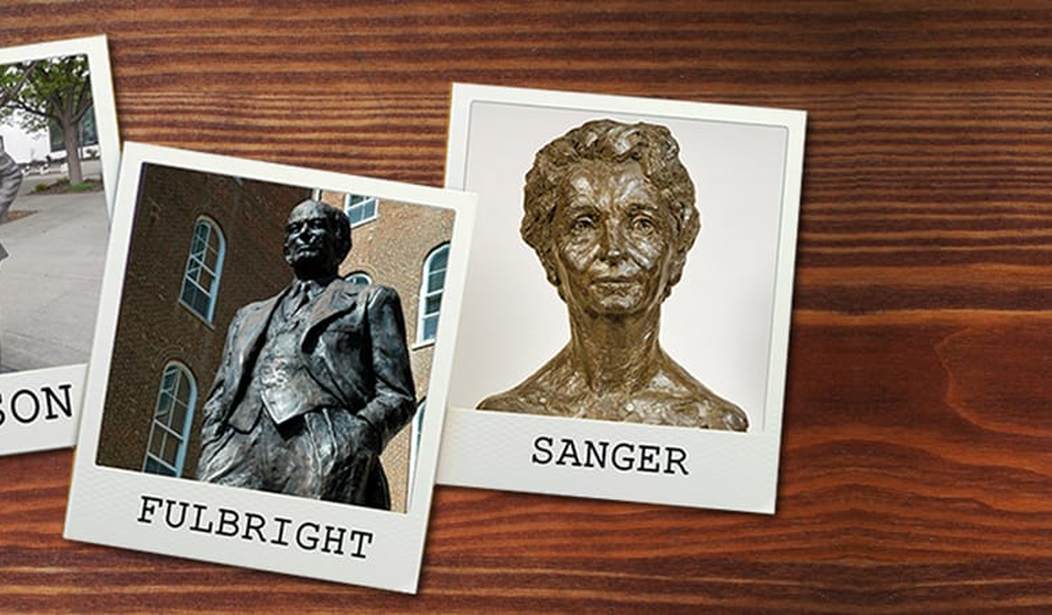After the clashes in Charlottesville, a mania against Confederate monuments has swept the country. Local leaders in various states have decided to remove statues and monuments, while at least one black pastor in Chicago has called for excising even George Washington’s name from public parks, and Anonymous has planned to remove 11 statues on Friday.
One plausible response is to defend the statues. Another would be to encourage the movement to go further.
Activists who cry for the removal of Confederate statues do so on the grounds that these leaders were racist, that they hurt people based on the color of their skin or their national origin. If those are the criteria, however, why stop with the Confederacy?
Racism has a long and varied history, and certainly these social justice warriors wouldn’t want to defend racists, even if they were important inventors, politicians, or scientists, right?
Here are six people whose statues should be removed, if the Left insists on that sort of thing.
1. Woodrow Wilson (1856-1924).
Woodrow Wilson, America’s 28th president, wasn’t just a racist. As president of Princeton University, he discouraged blacks from applying for admission. His book series History of the American People defended Ku Klux Klan lynchings in the late 1860s.
When Wilson was president, his War Department drafted black soldiers, and while it paid them the same as whites, it kept them in all-black units with white officers. When black soldiers protested, Wilson told them “segregation is not a humiliation but a benefit, and ought to be so regarded by you gentlemen.”
The pro-KKK film The Birth of a Nation became the first film screened in the White House under Wilson’s presidency. Under Wilson, racial segregation was implemented in the federal government, at the Post Office, and in the military.
In 2015, the University of Texas removed a statue of Wilson, along with one of Confederate President Jefferson Davis, from campus. Statues of Wilson remain, however. Many stand across Europe, a prominent one stands in Rapid City, S.D., (pictured at left in photo atop article), and his presidential library and museum gives prominence to his birthplace in Staunton, Va.
2. Alexander Graham Bell (1847-1922).

Bell Statue in front of the Brantford Bell Telephone Building. Photo credit: the city of Brantford, Ontario.
Alexander Graham Bell deserves recognition for inventing the telephone, but he was also a horrible racist. Bell served as honorary president of the Second International Eugenics Conference in New York in 1921, and led the eugenics movement during that period.
Based on the naturalistic worldview of Charles Darwin, many scientists in the early 20th century adopted the idea that human beings needed to continue to evolve — that natural selection involved choosing the strong over the weak, and that therefore human society should promote the existence of strong people at the expense of the “less fit.”
Eugenics leaders saw evolutionary fitness in explicitly racial terms.
Bell made a hobby out of breeding livestock, and this gained him an appointment to biologist David Starr Jordan’s Committee on Eugenics, which extended the principles of breeding to humans. From 1912 to 1918, Bell was the chairman of the board of scientific advisers to the Eugenics Record Office. Such organizations advocated for laws to establish compulsory sterilization for people who, in Bell’s words, were a “defective variety of the human race.”
To make matters worse, California’s compulsory sterilization law (one of the results of Bell’s advocacy) was used as a model for that of Nazi Germany.
The most famous and impressive monuments to Bell are in Canada. A statue depicting Bell in the style of the Lincoln Memorial stands by the Bell Telephone Building in Brantford, Ontario. The Alexander Graham Bell National Historic Site rests in Baddeck, Nova Scotia. Alexander Graham Bell Memorial Park has a monument to telecommunications.
In the U.S., the Alexander Graham Bell Laboratory stands in the Washington, D.C. suburb of Georgetown. The laboratory was created by Bell himself for the research and development of telecommunications technology.
3. Margaret Sanger (1879-1966).
The founder of Planned Parenthood herself, Margaret Sanger, may not have been a racist exactly, but she was a classist and fellow traveler in the eugenics movement.
After World War I, she lamented that the affluent and educated limit their child-bearing, while the poor and ignorant had more children. She sought to “assist the race toward the elimination of the unfit.” While she rejected race as a determining factor, she still sought to control who should and should not have children.
In a 1939 letter to black pastors, she infamously wrote, “We do not want word to go out that we want to exterminate the Negro population, and the minister is the man who can straighten out that idea if it ever occurs to any of their more rebellious members.”
Sanger advocated sterilization for the unfit, and she lived in a time when racism was considered scientifically credible. She opposed the Nazis and donated to the American Council Against Nazi Propaganda, and she believed the responsibility for birth control should fall on able-minded parents rather than the state.
Even so, Sanger’s calls for preventing the “unfit” from having children should legitimately shock Americans, and abortion has disproportionately hit the black population. Sanger may not have been a racist per se, but if statues are being removed, hers should be on the list. Not only was she a fellow traveler for eugenics, but she founded America’s largest abortion provider, undermining the right to life for generations.
A bust of Sanger (pictured at right in photo atop this article) was sculpted in the early 1970s by artist Joy Buba, and is on display in the National Portrait Gallery of the Smithsonian Institution. Two years ago, a group of pro-life protesters, most of whom were black, urged the Smithsonian to remove it.
4. Franklin Delano Roosevelt (1882-1945).

President Franklin Delano Roosevelt at the FDR memorial in the Tidal Basin, Washington, D.C. Photo Credit: Tyler O’Neil.
America’s 32nd president, Franklin Delano Roosevelt, may have led America through World War II against the Nazis, but he also seized and relocated hundreds of thousands of first-generation Japanese immigrants in “internment” camps.
FDR’s government seized these people’s assets and carted them off to camps in harsh locations. In December 1941, when Germany and Italy declared war on the U.S., many Germans and Italians were also arrested and placed in camps.
While this was a war tactic, intended to prevent espionage and sabotage, many consider it a long-lasting racist crime of discrimination against Japanese people.
Although polls often rank FDR as the second or third greatest president (partially due to the misconception that the New Deal or World War II ended the Great Depression), Japanese internment will always be a part of his legacy.
Roosevelt’s home in Hyde Park is now a national historic site and home to his presidential library. His retreat in Georgia is a museum. The president has a huge memorial (7.5 acres) in the Tidal Basin in Washington, D.C., along with a marble block in front of the National Archives. Social justice warriors should protest both locations.
5. J. William Fulbright (1905-1995).
Sen. J. William Fulbright (D-Ark.) supported segregation and opposed the Civil Rights Act of 1964. While he later repented of his racist positions, that makes him little better than Robert E. Lee (who emphatically supported the Union after the Civil War) or George Washington (who freed his slaves after his death).
Fulbright signed the Southern Manifesto in opposition to the Supreme Court’s ruling against segregation in the 1954 Brown v. Board of Education decision. In 1964, Fulbright joined with other southern Democrats in filibustering the Civil Rights Act of 1964. He also voted against the 1965 Voting Rights Act.
The Civil Rights Act of 1964 passed with 61 percent of House Democrats and 80 percent of House Republicans. In the Senate, 69 percent of Democrats supported it, compared with 82 percent of Republicans.
Despite his earlier support for segregation and opposition to civil rights, Fulbright later changed sides. President Bill Clinton acknowledged his switch and presented him the Presidential Medial of Freedom in 1993. Clinton called him “my mentor and friend.”
The University of Arkansas has a statue of Fulbright. In 1996, The George Washington University renamed a residence hall in his honor. The Fulbright Program for international student exchange, established in 1964, awards approximately 6,000 new grants annually. Approximately 294,000 people (111,000 from the U.S. and 183,000 from abroad) have participated in the program.
Even so, Fulbright opposed civil rights. Social justice warriors should protest the program, demand the removal of the statue, and rename the George Washington University residence hall after someone who didn’t oppose civil rights.
6. Robert Byrd (1917-2010).

A members of the West Virginia National Guard takes a photo of a memorial at the statue of the late Sen. Robert C. Byrd, at the Capitol in Charleston, WV., Thursday, July 1, 2010. (AP Photo/Steve Helber)
In the early 1940s, Robert Byrd recruited 150 friends and associates to create a chapter of the Ku Klux Klan in Sophia, West Virginia. He became a recruiter and the leader of his chapter, and when it came time to elect the top officer (the “Exalted Cyclops”) in the Klan unit, Byrd won unanimously.
“I shall never fight in the armed forces with a negro by my side. … Rather I should die a thousand times, and see Old Glory trampled in the dirt never to rise again, than to see this beloved land of ours become degraded by race mongrels, a throwback to the blackest specimen form the wilds,” Byrd wrote to segregationist Sen. Theodore G. Bilbo (D-Miss.).
In 1952, when Byrd ran for the U.S. House of Representatives, he said he lost interest in the Klan “after about a year,” but he wrote a 1946 letter to a Grand Wizard praising the Klan.
Byrd went on to become a member of the U.S. House and U.S. Senate. He later called joining the KKK “the greatest mistake I ever made.” In 2005, he said, “I know now I was wrong. Intolerance had no place in America. I apologized a thousand times … and I don’t mind apologizing over and over again. I can’t erase what happened.”
Byrd endorsed Barack Obama for president in 2008, and Hillary Clinton later called him the “heart and soul” of the United States Senate. The West Virginia State Capitol has a statue of Byrd, and various laboratories, community centers, and government buildings bear his name.
If the social justice warriors want a KKK member to protest, they have many Robert Byrd memorials to choose from. Yes, Byrd relented and swore off the KKK, but Lee also swore off the Confederacy, Washington freed his slaves, and Thomas Jefferson’s own Declaration of Independence inspired abolitionism.
If the Left insists on removing the monuments of repentant historical figures, why not include Fulbright and Byrd?
This is far from an exhaustive list. President Donald Trump asked “where does it stop?” Rationally, there is little reason for it to ever stop.
Has there ever been a perfectly good historical figure, by the SJWs standards? Even Jesus Christ, for all his preaching about helping the poor and needy, his raising people from the dead and healing their diseases, insisted that God was male, condemned sex outside of marriage, and led a movement whose disciples were anti-abortion and homophobic.
Will the Left demand statues of Jesus also be removed? Just wait until they hear the traditions about Mohammed.










Join the conversation as a VIP Member